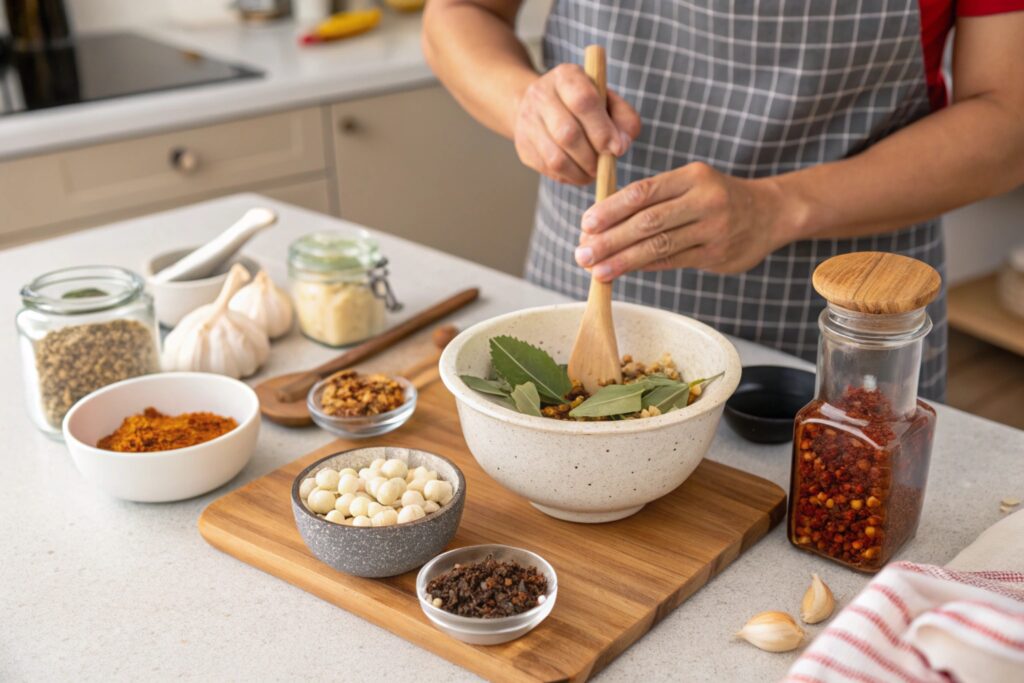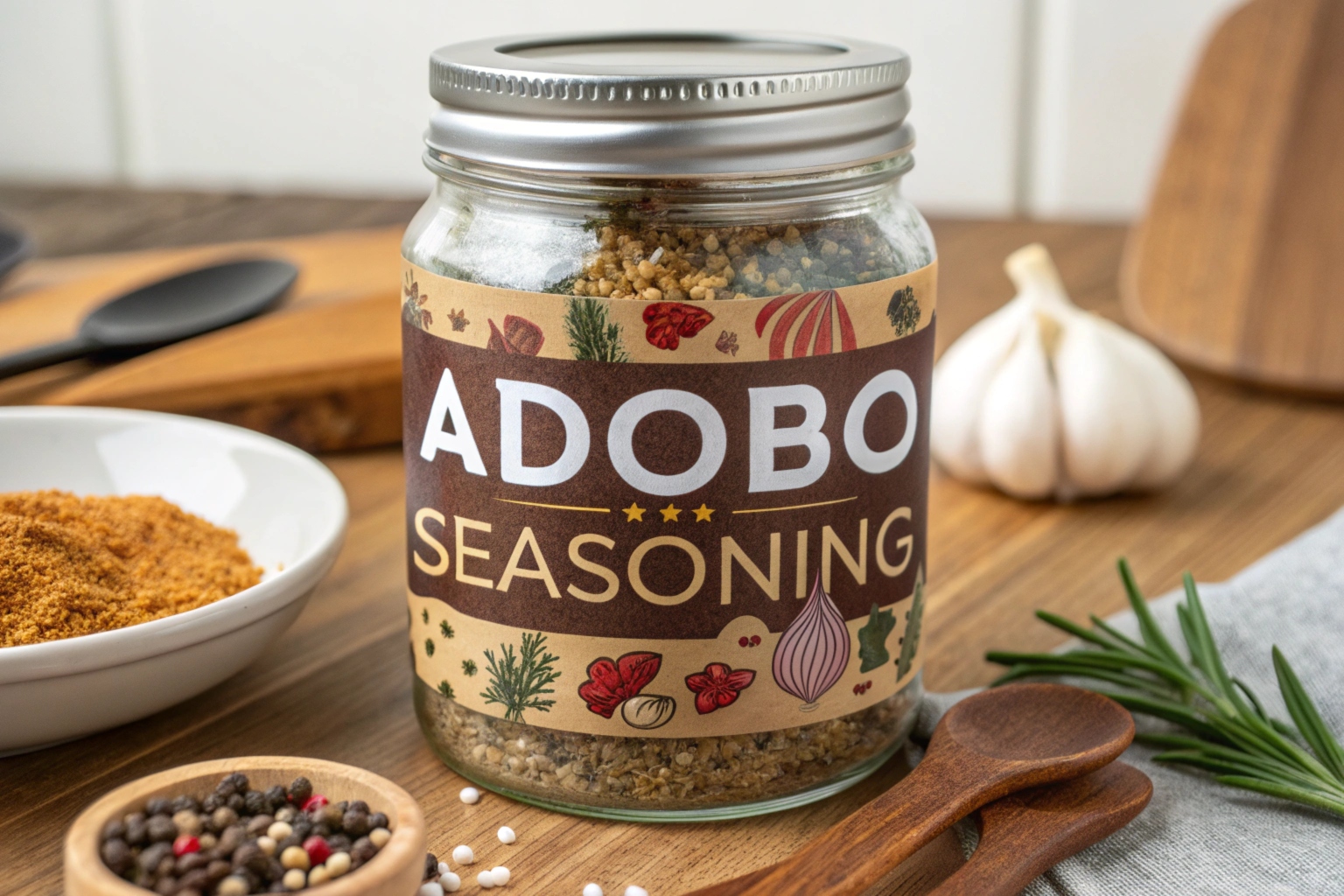When it comes to enhancing flavors in American cuisine or globally inspired dishes, few blends are as versatile and flavorful as Adobo Seasoning. This guide will delve into its essential components, cultural significance, culinary applications, and even step-by-step instructions for crafting your own homemade adobo seasoning. Prepare to elevate your kitchen game with this all-in-one seasoning recipe!
Essential Components of Adobo Seasoning
The foundation of any great adobo blend lies in its ingredients. These elements come together to create the signature taste of this iconic seasoning.
Key Ingredients:
- Garlic Powders: A cornerstone of adobo seasoning, tablespoons garlic powder provide the savory umami base for this mix.
- Onion Powder: Another essential, tablespoon onion powder enhances the depth of flavor.
- Kosher Salt: The coarse texture of kosher salt balances and preserves the seasoning.
- Ground Black Pepper: Teaspoons ground black pepper add a mild spiciness.
- Chili Powder: A dash of teaspoon chili powder introduces heat and a subtle smoky note.
- Paprika: This ingredient, often used in tablespoon paprika quantities, gives its signature reddish hue.
- Cayenne Pepper: For a touch of extra heat, a pinch of cayenne elevates the mix.
Optional Additions:
- Oregano
- Turmeric
- Lemon zest (for tangy variations)
- Cumin (to add earthy undertones)
The beauty of homemade adobo seasoning lies in the flexibility of these ingredients. Adjust to your liking, ensuring every dish has a personal touch.
Cultural Significance of Adobo Seasoning
Adobo has deep roots in Filipino, Latin American, and Caribbean cuisines. While the concept of “adobo” originated from the Spanish word for “marinade,” its cultural adaptations tell a rich story of trade, colonization, and culinary innovation.
- Filipino Adobo: Known for its wet marinade form, it combines soy sauce, vinegar, and garlic to create savory dishes.
- Caribbean Adobo: Used mainly as a dry adobo seasoning, it serves as a rub for meats and vegetables.
- American Cuisine Fusion: In the U.S., adobo seasoning has become a pantry staple, used for grilling, roasting, and even as a popcorn topping.
Understanding its historical and cultural relevance adds depth to your culinary creations, transforming simple meals into stories on a plate.
Adobo vs. Sazon: Key Differences
Though often confused, adobo seasoning and Sazon are distinct blends.
- Adobo Seasoning:
- Focuses on garlic, onion, black pepper, and paprika.
- Primarily used as a marinade or rub.
- Sazon:
- Includes annatto (achiote) for a vibrant orange color.
- Often contains MSG for an umami punch.
- Frequently used to flavor stews and soups.
While both add complexity to dishes, their unique profiles cater to different flavor needs.
Homemade Variations of Adobo

Crafting homemade adobo seasoning allows you to tailor the blend to your preferences. Consider these variations:
- Smoky Adobo: Add smoked paprika and chipotle powder.
- Spicy Adobo: Increase the cayenne pepper for a fiery kick.
- Citrus Adobo: Incorporate dried lemon or orange zest for a tangy twist.
- Herbal Adobo: Use dried thyme or rosemary for an aromatic profile.
Making your own ensures you have a preservative-free, customizable mix on hand.
Traditional Recipes
Traditional uses are rooted in family recipes and regional specialties. Common applications include:
- Adobo Chicken: A wet marinade of vinegar, garlic, and spices.
- Pork Adobo: Rubbed with a dry adobo seasoning before slow-cooking.
- Seafood Adobo: Infused with citrus zest and black pepper for a zesty flavor.
These recipes showcase the adaptability of this spice blend in global cuisines.
Customizing Flavors
Adjusting ratios in your adobo blend allows for endless experimentation. Here are some tips:
- Balance the heat with chili powder and cayenne.
- For sweeter dishes, add a hint of brown sugar.
- Enhance smokiness with a tablespoon paprika.
Keep a small batch in an airtight container for everyday use and experiment with new combinations as needed.
Culinary Uses of Adobo Seasoning
Meat and Poultry Dishes
- Rub adobo seasoning onto chicken wings or pork chops before grilling.
- Use it as a crust for roasted lamb or turkey.
Vegetable and Bean Recipes
- Sprinkle on roasted sweet potatoes or carrots.
- Season black beans or chickpeas for salads and wraps.
Marinades and Sauces
- Combine adobo seasoning with olive oil for a quick marinade.
- Blend with yogurt for a creamy dipping sauce.
The versatility of adobo seasoning makes it indispensable in the kitchen.
How to make the adobo seasoning
Making your own homemade adobo seasoning is quick and easy, allowing you to customize the flavor profile to suit your taste. Follow these simple steps to create your own versatile spice blend.
Ingredients
- Common spices for adobo seasoning may include:
- Garlic powder
- Onion powder
- Oregano
- Salt
- Black pepper
Note: Feel free to add other spices like cumin, paprika, red pepper, turmeric, or dried citrus based on your preference.
Instructions
- Combine Ingredients: In a small bowl, mix together all the selected spices until they are evenly distributed.
- Transfer to Container: Once mixed, transfer the seasoning blend to a small spice jar or container for storage.
- Store Properly: Keep your homemade adobo seasoning in a cool, dark place with your other dry spice blends to maintain its freshness.
Usage
- Use adobo seasoning as an all-purpose seasoning for meats, vegetables, or rice dishes.
- It can also serve as a dry rub or marinade base for various proteins.
Enjoy!
With just a few minutes of prep, you can enjoy the rich flavors of homemade adobo seasoning in your favorite dishes!
Storing Adobo Seasoning Effectively
Proper storage ensures your homemade adobo seasoning retains its potency.
- Use an airtight container: Prevents moisture and maintains freshness.
- Store in a cool, dark place: Prolongs shelf life.
- Avoid contamination: Use a dry spoon when scooping.
Investing in a quality spice grinder or coffee grinder can also help achieve the perfect texture for your mix.
Step-by-Step Guide to Creating Adobo Seasoning from Scratch
Ingredients:
- 3 tablespoons garlic powder
- 1 tablespoon onion powder
- 1 tablespoon paprika
- 2 teaspoons ground black pepper
- 1 teaspoon chili powder
- 2 teaspoons kosher salt
- 1/4 teaspoon cayenne pepper
Instructions:
- Combine all ingredients in a mixing bowl.
- Blend thoroughly using a spice grinder for a uniform texture.
- Store in an airtight container for up to six months.
By making your own, you can enjoy the freshest adobo blend tailored to your taste.
Alternative Uses for Adobo Seasoning
Adobo seasoning is not only a versatile spice blend for traditional Latin American dishes but also a fantastic ingredient to elevate a wide variety of foods. Here are some creative alternative uses for adobo seasoning that can bring exciting flavors to your cooking:
Flavor Booster for Soups and Stews
Adobo seasoning can add depth and warmth to your soups and stews. Simply sprinkle a teaspoon or two into your pot while cooking to enhance the overall flavor profile. It pairs particularly well with beans, lentils, and vegetable soups, giving them a rich, savory taste.
Seasoning for Snacks
Give your snacks a flavorful twist by sprinkling adobo seasoning on popcorn, roasted nuts, or tortilla chips. The zesty and aromatic notes can transform bland snacks into something irresistible, making them perfect for parties or movie nights.
Salad Enhancer
Instead of relying on traditional dressings, try mixing adobo seasoning with olive oil and vinegar to create a zesty vinaigrette. This can be drizzled over salads for an added kick or used to marinate salad ingredients like cucumbers and tomatoes before serving.
Flavored Rice and Grain Dishes
Elevate your rice, quinoa, or couscous by stirring in some adobo seasoning while cooking. It infuses the grains with flavor, making them a delicious side dish that pairs well with a variety of main courses.
Deviled Eggs or Potato Salad
Mix adobo seasoning into the filling for deviled eggs or as part of the dressing in potato salad. Its unique flavor will surprise and delight your guests, adding an exciting twist to these classic recipes.
Vegetable Roasting
Before roasting your vegetables, toss them with a generous amount of adobo seasoning. This will not only season them beautifully but will also enhance their natural sweetness through caramelization.
Grilled Cheese or Sandwich Spread
For a unique spin on your classic grilled cheese or sandwiches, mix adobo seasoning into your mayonnaise or butter. This will add a burst of flavor that complements the cheese and other ingredients perfectly.
Incorporating adobo seasoning into your cooking routine can open up a world of flavor possibilities. Experiment with these alternative uses, and you’ll find that this simple spice blend can be the secret ingredient to many dishes!
Community Feedback and Insights
Home cooks and chefs alike praise adobo seasoning for its balance and flavor. Common suggestions include:
- Doubling the garlic for a robust taste.
- Mixing with lemon juice for a quick salad dressing.
- Pairing with honey for a sweet-spicy glaze.
Engage with food forums to discover unique applications and share your recipes.
Related Questions:
What is adobo seasoning made of?
A blend of garlic, onion, paprika, chili powder, black pepper, and kosher salt.
What is the Flavor of Adobo?
Adobo seasoning is characterized by its robust, garlicky, and herbaceous profile. It typically combines flavors from garlic and onion powders, cumin, oregano, paprika, and turmeric, resulting in a savory blend that enhances a variety of dishes. The flavor can vary based on the ingredient proportions; a higher amount of garlic and onion yields a milder, paler mix, while increased paprika and turmeric contributes to a bolder, more colorful seasoning. Adobo is an excellent choice for those looking to add depth and warmth to their culinary creations.
In summary, it is savory, slightly smoky, and balanced with mild heat.
What is a good substitute for adobo seasoning?
A mix of garlic powder, onion powder, paprika, and black pepper.
Is adobo seasoning the same as Cajun seasoning?
No, Cajun seasoning includes herbs like thyme and oregano, offering a different flavor profile.
Conclusion: Elevating Culinary Creations with Adobo
Whether you’re crafting a traditional dish or exploring new culinary horizons, adobo seasoning is your ticket to flavor-packed meals. By making your own, you unlock endless possibilities to customize, savor, and share the magic of this versatile blend. So grab your spice grinder, whip up a batch, and transform your dishes with this timeless seasoning recipe!

